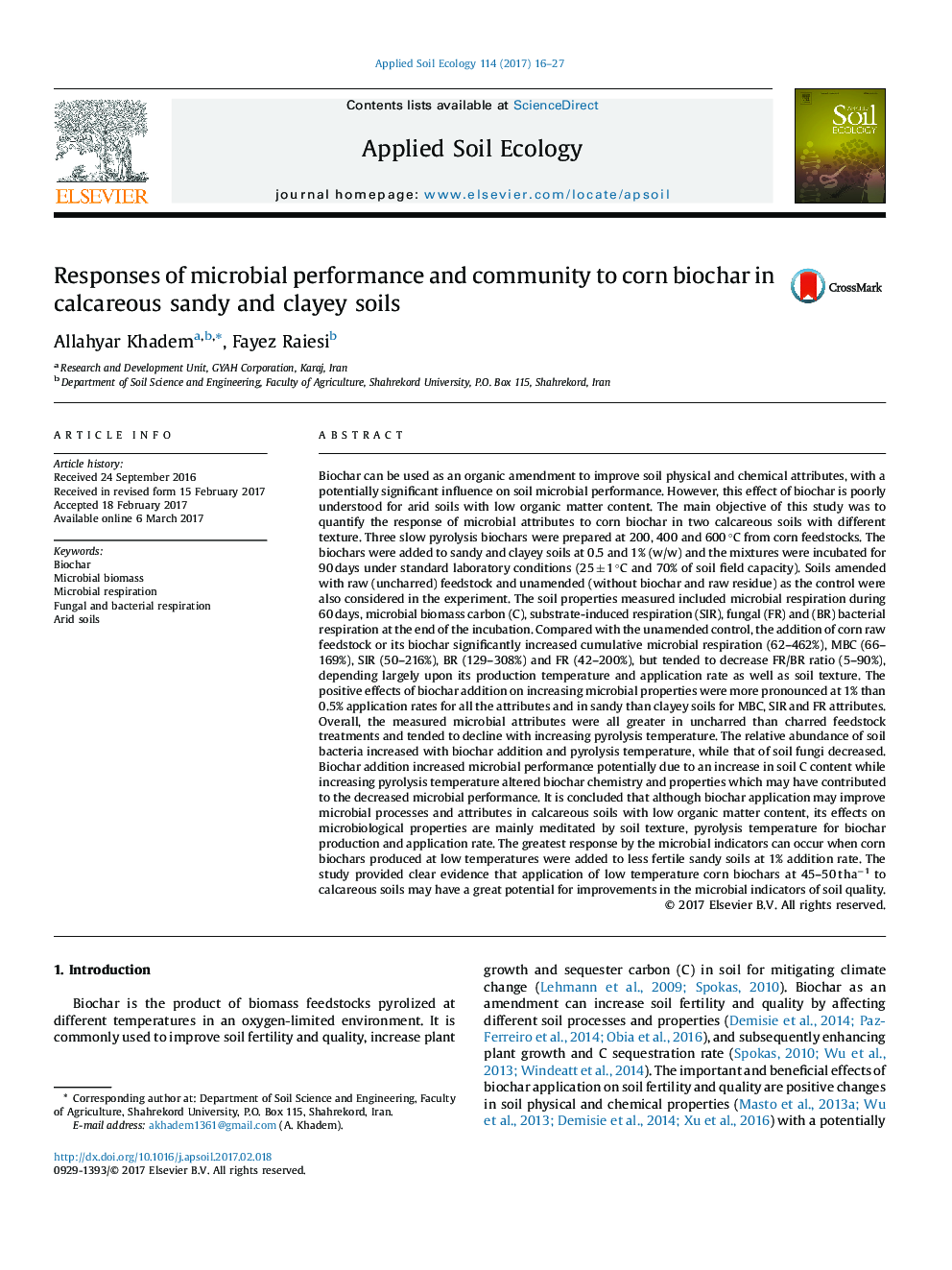| کد مقاله | کد نشریه | سال انتشار | مقاله انگلیسی | نسخه تمام متن |
|---|---|---|---|---|
| 5742709 | 1617769 | 2017 | 12 صفحه PDF | دانلود رایگان |
- Biochar addition stimulated soil microbial biomass (MB) and respiration (MR).
- MB and MR decreased with increasing pyrolysis temperature in calcareous soils.
- Positive effects of corn biochar on MB were much greater in sandy than clayey soils.
- Beneficial effects of biochar on MR were much higher in clayey than sandy soils.
- Biochar impact on soil microbial performance was larger at 1% than 0.5% rates.
Biochar can be used as an organic amendment to improve soil physical and chemical attributes, with a potentially significant influence on soil microbial performance. However, this effect of biochar is poorly understood for arid soils with low organic matter content. The main objective of this study was to quantify the response of microbial attributes to corn biochar in two calcareous soils with different texture. Three slow pyrolysis biochars were prepared at 200, 400 and 600 °C from corn feedstocks. The biochars were added to sandy and clayey soils at 0.5 and 1% (w/w) and the mixtures were incubated for 90 days under standard laboratory conditions (25 ± 1 °C and 70% of soil field capacity). Soils amended with raw (uncharred) feedstock and unamended (without biochar and raw residue) as the control were also considered in the experiment. The soil properties measured included microbial respiration during 60 days, microbial biomass carbon (C), substrate-induced respiration (SIR), fungal (FR) and (BR) bacterial respiration at the end of the incubation. Compared with the unamended control, the addition of corn raw feedstock or its biochar significantly increased cumulative microbial respiration (62-462%), MBC (66-169%), SIR (50-216%), BR (129-308%) and FR (42-200%), but tended to decrease FR/BR ratio (5-90%), depending largely upon its production temperature and application rate as well as soil texture. The positive effects of biochar addition on increasing microbial properties were more pronounced at 1% than 0.5% application rates for all the attributes and in sandy than clayey soils for MBC, SIR and FR attributes. Overall, the measured microbial attributes were all greater in uncharred than charred feedstock treatments and tended to decline with increasing pyrolysis temperature. The relative abundance of soil bacteria increased with biochar addition and pyrolysis temperature, while that of soil fungi decreased. Biochar addition increased microbial performance potentially due to an increase in soil C content while increasing pyrolysis temperature altered biochar chemistry and properties which may have contributed to the decreased microbial performance. It is concluded that although biochar application may improve microbial processes and attributes in calcareous soils with low organic matter content, its effects on microbiological properties are mainly meditated by soil texture, pyrolysis temperature for biochar production and application rate. The greatest response by the microbial indicators can occur when corn biochars produced at low temperatures were added to less fertile sandy soils at 1% addition rate. The study provided clear evidence that application of low temperature corn biochars at 45-50 t haâ1 to calcareous soils may have a great potential for improvements in the microbial indicators of soil quality.
Journal: Applied Soil Ecology - Volume 114, June 2017, Pages 16-27
